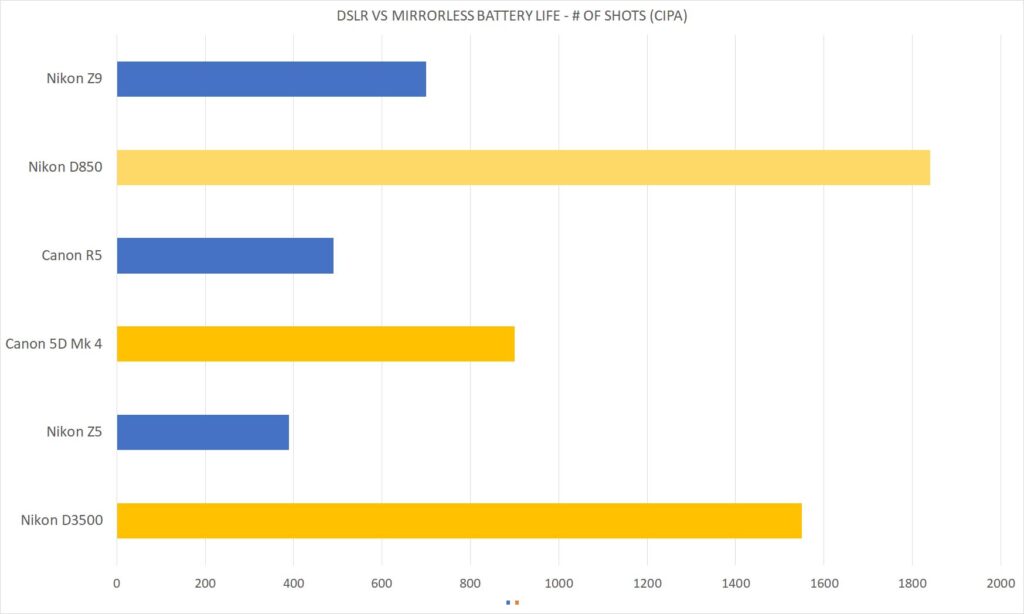You would be forgiven for thinking DSLRs are dead. But, in an interview with DPReview, Canon’s senior executive team confirmed that the DSLR is still alive and kicking.
Yet, Mirrorless cameras already account for approximately 70% of the market and growing, and even Canon themselves admit to directing development efforts away from DSLR to mirrorless. Nevertheless, here are 5 Reasons why the DSLR isn’t going anywhere yet.
1. DSLRs are Cheaper
So far, mirrorless cameras have been more expensive than their DSLR equivalents. For instance, the Canon EOS Rebel T7 costs just US$399 with a lens.

In contrast, the Canon M50 and Canon R50 cost $699 and $799, respectively. As a result, DSLRs are likely to remain popular in emerging markets for some time.
2. DSLRs offer comparable Image Quality
Despite being cheaper, DSLRs deliver the same levels of image quality as Mirrorless cameras and, in many cases, even use the same image sensors.

Technically speaking, DSLRs may have slightly better image quality since their sensors are not giving up pixels for on-sensor phase detect autofocus. However, spotting the difference in real-world use would not be easy.
3. DSLRs have more Lenses
DSLRs have more lenses to choose from. For instance, Nikon’s DSLR F Mount has just over 65 lenses on sale, plus a vast back catalog of legacy glass. In contrast, Nikon’s Z mount is limited to just 36 lenses.

Thus, if you’re looking for an older bargain or something exotic such as a tilt-shift, fish eye, or a super telephoto lens – you’re probably looking for a DSLR lens.
4. Battery Life
DSLRs are vastly less power-hungry than a mirrorless cameras because the image sensor does not need to provide a real-time live feed to a rear screen or electronic viewfinder.

As a result, DSLR battery life, in practical terms, can be measured in weeks rather than days. Plus, it doesn’t matter if you forget to switch your DLSR off because it’s hardly using any power anyway.
5. Optical View Finders
Electronic viewfinders have come a long way but even the best; high-resolution EVFs have problems – notably lag. Specifically, many EVFs cannot keep up with fast shooting and tend to freeze or lag behind your moving subject.
Fortunately, with the arrival of fast read-out imaging sensors, we’re now seeing lag-free, and even black-out-free, EVFs. However, these EVFs are limited to more expensive cameras such as the Sony A1, Nikon Z9, and OM1.
In contrast, even the cheapest DSLR features a high-resolution optical viewfinder that refreshes at the speed of light.
Get Discounts on Photo Editing Software
Subscribe to my weekly newsletter and be notified of deals and discounts on photography software from ON1, Adobe, Luminar, and more. Spam Promise: Just one email a week, and there’s an unsubscribe link on every email.
Should you switch from DSLR to Mirrorless?
Technically speaking, Mirrorless cameras are superior to DLSRs. But in practical terms, Mirrorless cameras only benefit certain use cases, such as shooting portraits and video.
If you shoot landscapes or fast action, you may prefer a DSLR’s robust battery life, lag-free viewfinder, and lower list price. And regarding image quality, you’re not giving up anything and will likely have access to a broader selection of lenses.
But the day is coming when Mirrorless cameras, at any price, will be superior to DSLRs. But that day is not today.
Subscribe to my weekly newsletter to be notified of deals and discounts on photography software and gear. Subscribe Now.







